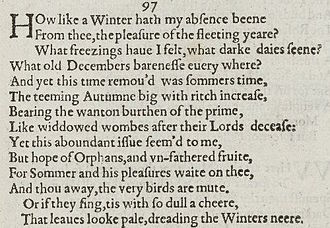Sonnet 24 is one of 154 sonnets written by the English playwright and poet William Shakespeare, and is a part of the Fair Youth sequence.

Sonnet 31 is one of 154 sonnets written by the English playwright and poet William Shakespeare. It is a sonnet within the Fair Youth sequence. Developing an idea introduced at the end of Sonnet 30, this poem figures the young man's superiority in terms of the possession of all the love the speaker has ever experienced.

Shakespeare's Sonnet 34 is included in what is referred to as the Fair Youth sequence, and it is the second of a briefer sequence concerned with a betrayal of the poet committed by the young man, who is addressed as a personification of the sun.
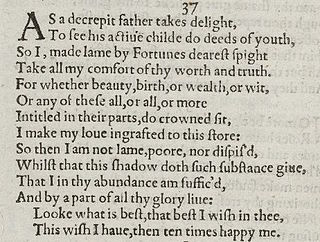
Shakespeare's Sonnet 37 returns to a number of themes sounded in the first 25 of the cycle, such as the effects of age and recuperation from age, and the blurred boundaries between lover and beloved. However, the tone is more complex than in the earlier poems: after the betrayal treated in Sonnets 34–36, the speaker does not return to a simple celebration.

Sonnet 38 is one of 154 sonnets written by the English playwright and poet William Shakespeare. It is a member of the Fair Youth sequence, in which the lyric subject expresses its love towards a young man.

William Shakespeare's Sonnet 43 employs antithesis and paradox to highlight the speaker's yearning for his beloved and sadness in their absence, and confusion about the situation described in the previous three sonnets. Sonnet 27 similarly deals with night, sleep, and dreams.
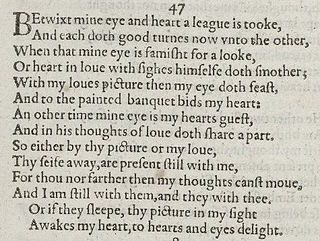
Shakespeare's Sonnet 47 is one of the Fair Youth sequence, addressed to a well-born young man. More locally, it is a thematic continuation of Sonnet 46.

Sonnet 48 is one of 154 sonnets written by the English playwright and poet William Shakespeare. It is a member of the Fair Youth sequence, in which the poet expresses his love towards a young man.

Sonnet 49 is one of 154 sonnets written by the English playwright and poet William Shakespeare. It is a member of the Fair Youth sequence, in which the poet expresses his love towards a young man.

Sonnet 51 is one of 154 sonnets written by the English playwright and poet William Shakespeare. It is part of the Fair Youth sequence, in which the poet expresses his love towards a young man. It is a continuation of the argument from Sonnet 50.

Shakespeare's Sonnet 58 is a syntactic and thematic continuation of Sonnet 57. More generally, it belongs to the large group of sonnets written to a young, aristocratic man, with whom the poem's speaker shares a tempestuous relationship. In this poem, the speaker complains of the beloved's voluntary absence, using the occasion to outline a more general lament against his own powerlessness and the indifference of the young man.

Sonnet 62 is one of 154 sonnets written by the English playwright and poet William Shakespeare. It is a member of the Fair Youth sequence, addressed to the young man with whom Shakespeare shares an intimate but tormented connection. This sonnet brings together a number of themes that run through the cycle: the speaker's awareness of social and other differences between him and the beloved; the power and limitations of poetic art; and the puzzling sense in which love erases the boundaries between individuals.
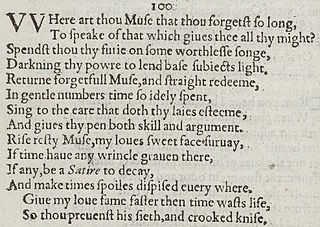
Sonnet 100 is one of 154 sonnets written by the English playwright and poet William Shakespeare. It is a member of the Fair Youth sequence, in which the poet expresses his love towards a young man.

Sonnet 67 is one of 154 sonnets written by the English playwright and poet William Shakespeare. It's a member of the Fair Youth sequence, in which the poet expresses his love towards a young man and is a thematic continuation of Sonnet 66. In this poem, the speaker's anxiety about the social difference between him and his beloved takes the form of a criticism of courtly corruption. This sonnet was placed first in the pirated and mangled edition of 1640.
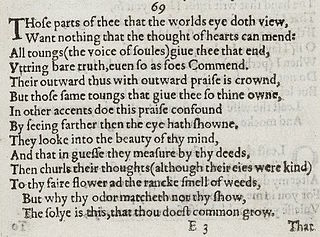
Shakespeare's Sonnet 69, like many of those nearby in the sequence, expresses extremes of feelings about the beloved subject, who is presented as at once superlative in every way and treacherous or disloyal.

Sonnet 98 is one of 154 sonnets written by the English playwright and poet William Shakespeare. It is a member of the Fair Youth sequence, in which the persona expresses his love towards a young man. It is the second of a group of three sonnets to treat a separation of the speaker from his beloved.
Sonnet 149 is one of 154 sonnets written by the English playwright and poet William Shakespeare.

Sonnet 95 is one of 154 sonnets written by the English playwright and poet William Shakespeare. It is a member of the Fair Youth sequence, in which the poet expresses his love towards a young man.

Sonnet 103 is one of 154 sonnets written by the English playwright and poet William Shakespeare. It is a member of the Fair Youth sequence, in which the poet expresses his love towards a young man.
Sonnet 120 is one of 154 sonnets written by the English playwright and poet William Shakespeare. It's a member of the Fair Youth sequence, in which the poet expresses his love towards a young man.
